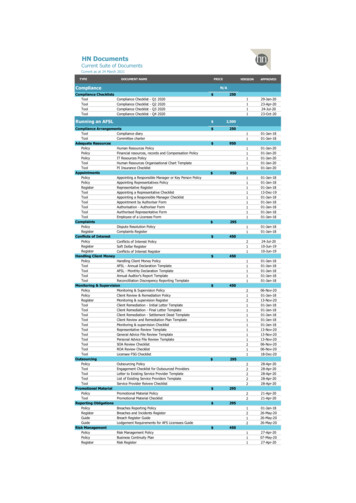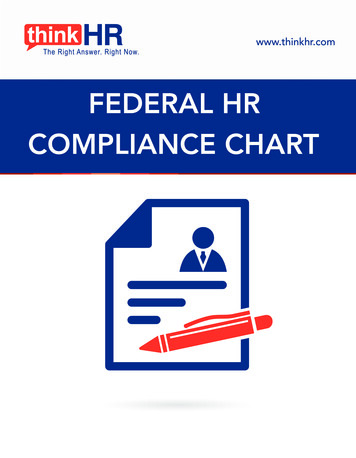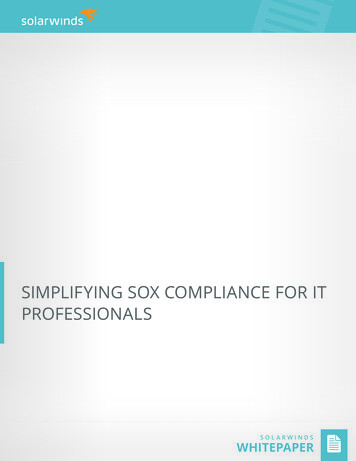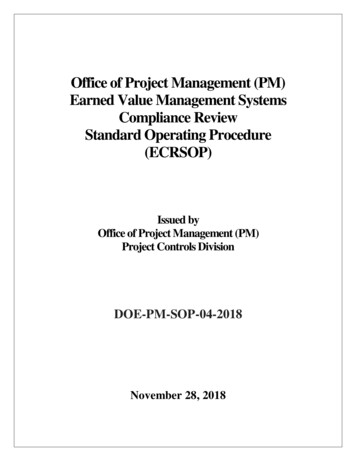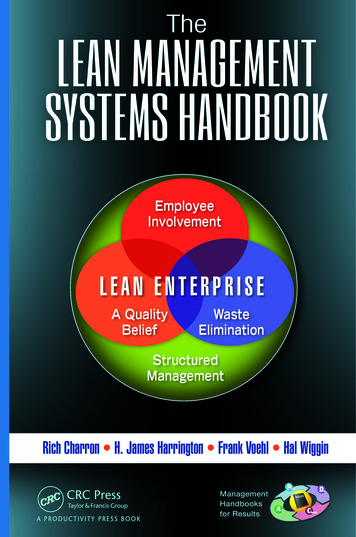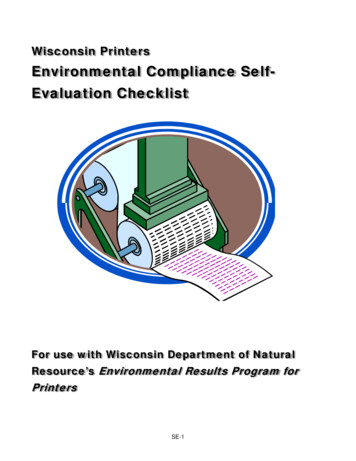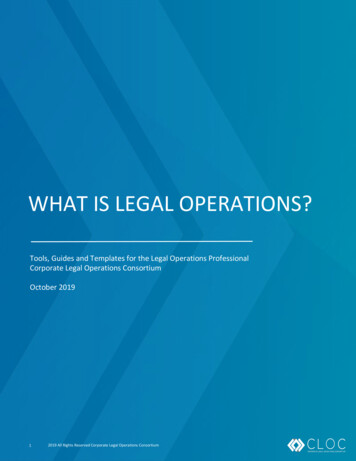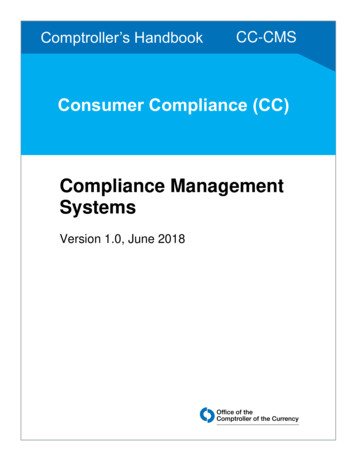
Transcription
Comptroller’s HandbookCC-CMSConsumer Compliance (CC)Compliance ManagementSystemsVersion 1.0, June 2018
Version 1.0ContentsIntroduction .1Compliance Management Systems Defined . 1Use of this Booklet. 1CMS Examinations . 2Community Reinvestment Act Considerations . 3Heightened Standards . 3Risks Associated With CMS. 4Compliance Risk . 4Operational Risk . 4Strategic Risk . 5Reputation Risk. 5CMS Components .6Board and Management Oversight . 6Oversight and Commitment . 6Change Management . 8Comprehension, Identification, and Management of Risk . 9Self-Identification and Corrective Action . 11Consumer Compliance Program . 11Policies and Procedures . 11Consumer Compliance Training . 12Monitoring and Audit . 13Consumer Complaint Resolution Process . 15Violations of Law and Consumer Harm . 16Examination Procedures .17Scope . 17Board and Management Oversight . 18Consumer Compliance Program . 22Conclusions . 25Appendix .26Appendix A: Uniform Interagency Consumer Compliance Rating System(CC Rating System) . 26References .37Comptroller’s HandbookiCompliance Management Systems
Version 1.0IntroductionThe Office of the Comptroller of the Currency’s (OCC) Comptroller’s Handbook booklet,“Compliance Management Systems,” is prepared for use by OCC examiners in connectionwith their examination and supervision of national banks, federal savings associations, andfederal branches and federal agencies of foreign banking organizations (collectively, banks).Each bank is different and may present specific issues. Accordingly, examiners should applythe information in this booklet consistent with each bank’s individual circumstances. When itis necessary to distinguish between them, national banks and federal savings associations arereferred to separately.The consumer compliance risk management principles in this booklet reflect the OCC’s riskbased supervision approach and are consistent with the OCC’s assessment of banks’ riskmanagement systems and the interagency consumer compliance rating definition. Theprinciples in this booklet do not set new or higher expectations for banks.Compliance Management Systems DefinedA bank’s overall compliance management system (CMS) includes policies, procedures,processes, monitoring and testing programs, and a compliance audit function regardingcompliance with all applicable laws and regulations. The abbreviation “CMS” in this bookletrefers to only those aspects of the bank’s overall CMS that pertain to the bank’s compliancewith consumer protection-related laws and regulations. An effective CMS includes processesand practices designed to manage consumer compliance risk, support compliance withconsumer protection-related laws and regulations, and prevent consumer harm. The primarycomponents of a CMS that examiners consider when evaluating a bank’s CMS include boardand management oversight and a compliance program. Table 1 outlines broadly whatexaminers consider when assessing board and management oversight and the complianceprogram, respectively.Table 1: CMS ComponentsBoard and management oversight Oversight and commitment,including oversight of thirdpartiesChange managementComprehension, identification,and management of risksSelf-identification and correctiveactionConsumer compliance program Policies and proceduresConsumer compliance trainingMonitoring and auditConsumer complaint responseUse of this BookletThis booklet provides background information and examination procedures for assessing abank’s CMS and assigning the consumer compliance component rating under the UniformComptroller’s Handbook1Compliance Management Systems
Version 1.0Interagency Consumer Compliance Rating System (CC Rating System). 1 Examiners decidewhich examination procedures in this booklet to use, if any, during examination planning orafter drawing preliminary conclusions during the compliance core assessment. Complaintinformation received by the Customer Assistance Group (CAG) in the OCC’s Office ofEnterprise Governance and the Ombudsman, by the Bureau of Consumer FinancialProtection (BCFP), 2 and by the bank may also be useful in completing the core assessment orexpanded procedures.Aspects of a bank’s overall CMS (i.e., those aspects not specific to consumer protectionrelated laws and regulations) should be considered when assessing the bank’s overall riskmanagement program and determining the management component rating. The assessment ofcompliance risk in the OCC’s Risk Assessment System (RAS) considers the bank’scompliance with all applicable laws and regulations (including those that extend beyondconsumer protection-related laws and regulations). Refer to the “Bank Supervision Process,”“Community Bank Supervision,” “Federal Branches and Agencies Supervision,” or “LargeBank Supervision” booklets of the Comptroller’s Handbook for additional informationregarding the core assessment, regulatory ratings, and the RAS.CMS ExaminationsExaminers must review the bank’s CMS during every supervisory cycle to complete theconsumer compliance core assessment and assign the consumer compliance componentrating. This may be done by conducting one supervisory activity or aggregating the results ofmultiple supervisory activities conducted during the supervisory cycle. The scope of theconsumer compliance examination, including the review of CMS, should be risk-based,although there are some subject areas that must be reviewed each cycle, either because of astatutory requirement or because of an OCC policy decision. Unless otherwise required,examiners should use judgment in determining whether transaction testing is warranted whenassessing the bank’s CMS. Refer to the “Bank Supervision Process” booklet of theComptroller’s Handbook for additional details on the scope of consumer complianceexaminations.When determining the consumer compliance component rating, examiners should considerthe effectiveness of the bank’s CMS for compliance with all applicable consumer protectionrelated laws and regulations (including, but not limited to, the Home Mortgage DisclosureAct [HMDA] 3 and fair lending-related laws and regulations [e.g., the Equal Credit1The OCC, along with the other members of the Federal Financial Institutions Examination Council (FFIEC),issued the revised CC Rating System on November 7, 2016, to reflect current supervisory approaches forconsumer compliance. Refer to 81 Fed. Reg. 79473, “Uniform Interagency Consumer Compliance RatingSystem,” and to appendix A of this booklet.2BCFP data are available for banks with total assets of more than 10 billion. CAG data for banks with totalassets of 10 billion or less include complaints originally sent to the BCFP.3Refer to “A Guide to HMDA Reporting: Getting It Right!” section 9.2, “Implementation and compliancemanagement support activities,” for information regarding HMDA-specific CMS considerations for banks.Comptroller’s Handbook2Compliance Management Systems
Version 1.0Opportunity Act and the Fair Housing Act]). Examiners should also consider laws andregulations for which the BCFP is assigned exclusive supervisory authority under the Dodd–Frank Wall Street Reform and Consumer Protection Act of 2010 (Dodd–Frank). 4 Examinersmust consider material information that the BCFP provides to the OCC when assigning theconsumer compliance rating for banks with more than 10 billion in total assets. OCCexaminers generally may not, however, conduct transaction testing 5 or determine compliancewith any law or regulation for which the BCFP is assigned exclusive supervisory authorityunder Dodd–Frank. Pursuant to the 2012 interagency memorandum of understanding onsupervisory coordination, 6 the OCC has established protocols for communicating materialsupervisory information to the BCFP. When OCC examiners identify a bank’s potential noncompliance with any law or regulation where the BCFP is assigned supervisory authority,examiners should consult with their supervisory office and follow OCC-establishedprocesses.Community Reinvestment Act ConsiderationsThe CC Rating System does not consider a bank’s CRA performance, as CRA performanceis evaluated separately and assigned its own component rating. Examiners should consultwith appropriate Compliance Supervision Management, Compliance Risk Policy, or Legalrepresentatives when considering CRA programmatic or risk management deficiencies in theCMS review.Heightened Standards12 CFR 30, appendix D, “OCC Guidelines Establishing Heightened Standards for CertainLarge Insured National Banks, Insured Federal Savings Associations, and Insured FederalBranches,” 7 applies to banks with average total consolidated assets of 50 billion or greateror those that the OCC designates as covered banks. For covered banks, certain CMScomponents discussed in this booklet may also need to be incorporated into the heightened4Section 1025 of Dodd–Frank (12 USC 5515) granted the BCFP exclusive authority to examine insureddepository institutions with more than 10 billion in total assets and their affiliates for compliance withenumerated Federal consumer financial laws. Refer to 12 USC 5481 for the definition of enumerated Federalconsumer financial laws. The prudential regulators retained authority for examining insured depositoryinstitutions with more than 10 billion in total assets for compliance with certain other laws related to consumerfinancial protection, including the Fair Housing Act, Servicemembers Civil Relief Act (SCRA), and section 5 ofthe Federal Trade Commission Act.5Examiners may conduct transaction testing in banks with assets of more than 10 billion to verify the accuracyand reliability of data a bank reports under the HMDA and Regulation C for use in CRA or fair lendingexaminations. Examiners may not cite violations in such cases but may direct the bank to correct the data beforeuse in CRA or fair lending examinations.6Refer to OCC News Release 2012-85, “Memorandum of Understanding on Supervisory Coordination.”7Refer to 12 CFR 30, appendix D, I.E.5, and to OCC Bulletin 2014-45, “Heightened Standards for LargeBanks; Integration of 12 CFR 30 and 12 CFR 170: Final Rules and Guidelines.”Comptroller’s Handbook3Compliance Management Systems
Version 1.0standards identified in 12 CFR 30, appendix D. Refer to the “Corporate and RiskGovernance” booklet of the Comptroller’s Handbook for additional information regardingheightened standards.Risks Associated With CMSFrom a supervisory perspective, risk is the potential that events will have an adverse effect ona bank’s current or projected financial condition 8 and resilience. 9 The OCC has defined eightcategories of risk for bank supervision purposes: credit, interest rate, liquidity, price,operational, compliance, strategic, and reputation. These categories are not mutuallyexclusive. Any product or service may expose the bank to multiple risks. Risks also may beinterdependent and positively or negatively correlated. Examiners should be aware of andassess the effect of this interdependence. Refer to the “Bank Supervision Process” booklet ofthe Comptroller’s Handbook for additional discussion of banking risks and their definitions.The primary risks associated with a bank’s CMS are compliance, operational, strategic, andreputation. These risks are discussed in more detail in the following paragraphs.Compliance RiskCompliance risk is the risk to a bank’s current or projected financial condition and resiliencearising from violations of laws or regulations or from nonconformance with prescribedpractices, internal bank policies and procedures, or ethical standards. The OCC expects theboard and management, collectively, to be responsible for the bank’s compliance with allapplicable laws and regulations. Failure to establish a sound CMS, which addresses allapplicable consumer protection-related laws and regulations, exposes the bank to increasedlegal and reputation risks and the potential for enforcement actions (including civil moneypenalties [CMP]), and customer reimbursements. Compliance risk can result in diminishedreputation, harm to bank customers, limited business opportunities, and lessened expansionpotential.Operational RiskOperational risk is the risk to current or projected financial condition and resilience arisingfrom inadequate or failed internal processes or systems, inappropriate accounting, humanerrors or misconduct, or adverse external events. Operational risk may be elevated whenbanks have higher volumes of loans, larger numbers of transactions processed, and moreextensive use of automation and technology. Highly automated environments poseheightened operational risk exposure that can result in compliance or reputation risk, asautomated environments can compound the exposure of errors. Operational risk can also8Financial condition includes effects from diminished capital and liquidity. Capital in this context includespotential effects from losses, reduced earnings, and market value equity.9Resilience recognizes the bank’s ability to withstand periods of stress.Comptroller’s Handbook4Compliance Management Systems
Version 1.0result when a bank outsources operational functions (e.g., loan origination, accountmanagement, collections, payment processing, data input, and legal assistance) to thirdparties. 10Strategic RiskStrategic risk is the risk to current or projected financial condition and resilience arising fromadverse business decisions, poor implementation of business decisions, or lack ofresponsiveness to changes in the banking industry and operating environment. Additionally,strategic risk increases when new activities are not compatible with the bank’s risk appetiteor strategic plan or do not provide an adequate return on investment; the bank engages in newactivities without performing adequate due diligence, including upfront expense analysis; ormanagement does not have adequate resources, expertise, and experience to properlyimplement and oversee the new activities. New activities should be developed andimplemented consistently with sound risk management practices and should align withbanks’ overall business plans and strategies. New activities should encourage fair access tofinancial services and fair treatment of consumers and should be in compliance withapplicable laws and regulations. 11 The board and senior management, collectively, are thekey decision makers who drive the strategic direction of the bank and establish governanceprinciples. The failure to integrate the bank’s CMS into its decision-making andimplementation process can have wide-ranging consequences. The consequences mayinclude missed business opportunities, losses, failure to comply with laws or regulations, ordeficient practices (including those that are unsafe or unsound) that could lead toenforcement actions, including CMPs.Reputation RiskReputation risk is the risk to earnings, capital, or enterprise value arising from negativepublic opinion. This risk may impair the bank’s competitiveness by affecting its ability toestablish new relationships or services or continue servicing existing relationships.Inadequate policies and procedures, operational breakdowns, or other weaknesses in thebank’s CMS can harm its reputation when these weaknesses result in violations of consumerprotection-related laws or regulations, particularly when consumers are harmed.Inappropriate delegation of activities to third parties and wrongful acts by third parties actingon the bank’s behalf may also increase a bank’s reputation risk exposure. Effective systemsand controls to identify, measure, monitor, and control potential issues, such as appropriateoversight of sales, servicing, and collection practices, are important to managing risks,including reputation, compliance, and operational risks.10Refer to OCC Bulletin 2013-29, “Third-Party Relationships: Risk Management Guidance,” OCC Bulletin2017-21, “Third-Party Relationships: Frequently Asked Questions to Supplement OCC Bulletin 2013-29,” andOCC Bulletin 2017-7, “Third-Party Relationships: Supplemental Examination Procedures,” for moreinformation regarding third-party risk management.11Refer to OCC Bulletin 2017-43, “New, Modified, or Expanded Bank Products and Services: RiskManagement Principles.”Comptroller’s Handbook5Compliance Management Systems
Version 1.0CMS ComponentsCMS is the method by which a bank manages consumer compliance risk, supportscompliance with consumer protection-related laws and regulations, and prevents consumerharm. The complexity of the compliance risk environment presents challenges for banks. Thevolume and complexity of consumer protection-related laws and regulations coupled withchanging technologies and earnings pressures increase the importance of a bank’s CMS.Each bank should develop and maintain an effective CMS that is appropriate for the size,complexity, and risk profile of its operations. The CMS should consist of board andmanagement oversight and a compliance program that includes all applicable consumercompliance-related laws and regulations.The consumer compliance rating takes into account the effectiveness of the bank’s CMS andfactors relating to violations of law and consumer harm. Refer to the “Violations of Law andConsumer Harm” section and appendix A of this booklet for additional information.Board and Management OversightBoard and management oversight should be commensurate with the bank’s size, complexity,and risk profile. Oversight should factor in all applicable consumer protection-related lawsand regulations and include consumer compliance expectations for third-party relationships.It is important for the board and management to understand the potential consequences ofviolations of laws and regulations that may result in customer reimbursements, financiallosses, reputation risks, and legal risks, including enforcement actions (including CMPs). Inrelation to their respective roles, board and management oversight should include thefollowing: Oversight of and a commitment to the bank’s CMS, including oversight of third parties.Effective change management processes, which include responding in a timely andsatisfactory manner to any change, internal or external, to the bank.Comprehension, identification, and management of risks arising from the bank’sproducts, services, or activities.Self-identification of consumer compliance issues and timely correction of such issues.Oversight and CommitmentThe board and management should demonstrate a commitment to and oversight of the bank’sCMS. 12 The board should oversee, and management should implement, a consumercompliance program with effective resources, including12Refer to the “Corporate and Risk Governance” booklet of the Comptroller’s Handbook for additionalinformation regarding the roles of the board and management in establishing an appropriate compliance culturethat incorporates all applicable laws and regulations, including consumer protection-related laws andregulations.Comptroller’s Handbook6Compliance Management Systems
Version 1.0 systems, capital, and human resources commensurate with the bank’s size, complexity,and risk profile.knowledgeable staff who are appropriately trained, empowered, and held accountable forcompliance with consumer protection-related laws and regulations.Board of DirectorsThe board should create a culture that places a priority on compliance and holds managementaccountable. The board plays a pivotal role in the effective governance of the bank, includingoversight of the bank’s CMS. The board should oversee management, provide organizationalleadership, and establish core corporate values. The board should oversee management’simplementation of the bank’s CMS and hold management accountable for implementing aCMS that is consistent with the bank’s strategic direction, risk culture, and risk appetite.The board should receive sufficient consumer compliance-related information includingmanagement information systems (MIS) reports, risk assessments, and monitoring andindependent audit reports to assess the effectiveness of the bank’s CMS and, whenappropriate, provide credible challenge to management. Applicable board or boardcommittee minutes should reflect the board’s or committee’s receipt and deliberation ofinformation related to the bank’s consumer compliance risk management practices and theeffectiveness of those practices to manage consumer compliance risk, support compliancewith consumer protection-related laws and regulations, and prevent consumer harm. Theboard should understand its roles and responsibilities related to consumer compliance, andperiodically assess directors’ consumer compliance skills and competencies relative to thebank’s size, complexity, and risk profile. Management can support the board by instituting anongoing education and training program that includes consumer compliance to keep theboard informed and current on general industry trends and regulatory developments,particularly regarding issues that pertain to the bank.Bank ManagementThe board generally delegates authority to management for directing and overseeing day-today operations of the bank, including developing and implementing the bank’s CMSconsistent with the board’s strategic objectives and risk appetite. Management shouldmonitor the performance of the compliance program, including third-party risk management processes that include due diligence and ongoing monitoringof third parties (i.e., third-party risk management processes).change management.comprehension, identification, and management of risk.self-identification of compliance risk management deficiencies and corrective action.Management may use committees to facilitate oversight of day-to-day banking activities,including consumer compliance-related activities. Management should determine whichcommittees are appropriate for the bank and how formal each committee’s structure shouldComptroller’s Handbook7Compliance Management Systems
Version 1.0be. Examples of consumer compliance-related committees may include compliance riskmanagement and fair banking.Management also should establish and clearly communicate compliance-related roles andresponsibilities. Regardless of the form of the compliance function, management shouldprovide it with appropriate resources, including systems, capital, and human resources. Manybanks establish a separate compliance function headed by a compliance officer. In suchbanks, the compliance officer should have the authority and independence to facilitatecompliance throughout the bank and sufficient time and resources, including staff, to executeassigned duties. The compliance officer should have the appropriate skills and knowledge ofthe consumer protection-related laws and regulations applicable to the bank. Complianceofficers should oversee the compliance training for all bank employees. For banks withlimited staff or overlapping compliance and other responsibilities, training and developmentis particularly important to conduct continuous and consistent operations. Additionally, thecompliance officer should be afforded opportunities for external training to maintain orrefresh his or her subject matter expertise pertinent to overseeing the bank’s complianceprogram.Third-Party Risk ManagementThere can be certain benefits to banks engaging in relationships with third parties, includinggaining operational efficiencies or an ability to deliver additional products and services.Third-party relationships may expose the bank to risks, if not managed effectively. Whilemanagement may make the business decision to outsource some or all of the operationalaspects of a product or service, the bank cannot outsource the responsibility for complyingwith consumer protection-related laws and regulations or managing the consumer compliancerisks associated with products or services offered by the third party. Management shouldimplement third-party risk management processes commensurate with the level of risk andcomplexity presented by the third-party relationships. The bank’s third-party riskmanagement process should include the following specific to consumer compliance: Due diligence and ongoing monitoring of third parties to assess compliance withconsumer protection-related laws and regulations.Oversight of third parties’ consumer compliance-related policies, procedures, internalcontrols, and training.Refer to OCC Bulletin 2013-29, “Third-Party Relationships: Risk Management Guidance,”OCC Bulletin 2017-21, “Third-Party Relationships: Frequently Asked Questions toSupplement OCC Bulletin 2013-29,” and OCC Bulletin 2017-7, “Third-Party Relationships:Supplemental Examination Procedures,” for additional information regarding third-party riskmanagement.Change ManagementSpecific to consumer compliance, management should anticipate and respond in a timelymanner to changes in applicable consumer protection-related laws and regulations, marketComptroller’s Handbook8Compliance Management Systems
Version 1.0conditions, and products and services offered by evaluating the change and implementingresponses across affected lines of business. Management should have a process to identifylaws and regulations applicable to the bank’s activities and stay abreast of evolvingregulatory requirements. The formality of the change management process should becommensurate with the bank’s size, complexity, and risk profile.Management should conduct due diligence in advance of engaging in new, modified, orexpanded products or services, consider the entire lifecycle of a product or service inimplementing change, and review the change after implementation to determine that actionstaken have achieved planned results. The compliance function should be involved in the duediligence and monitoring of new, modified, or expanded products or services. Refer to OCCBulletin 2017-43, “New, Modified, or Expanded Bank Products and Services: RiskManagement Principles,” for additional information.Comprehension, Identification, and Management of RiskManagement should comprehend, identify, and manage consumer compliance risks,including existing and emerging risks to the bank’s products, services, and other activities.The sophistication of risk management should be proportionate to the risks present and thebank’s size and complexity. Regardless of the bank’s size and complexity, soundmanagement of consumer compliance risk should do the following:Identify risk: The board and management should identify existing risks and risks that mayarise from new business initiatives, including risks that originate in nonbank subsidiaries,affiliates, and third-party relationships and those that arise from external market forces orregulatory or statutory changes. Risk identification should be a continual process and shouldoccur at the transaction, portfolio, and enterprise levels. For larger, more complex banks, theboard and management also should identify interdependencies and correlations acrossportfolios and lines of business that may amplify risk exposures. Proper risk identification isimportant for banks to determine that risks are addressed appropriately.Measure risk: Accurate and timely measurement of risks is important to effective riskmanagement systems
Comptroller’s Handbook 1 Compliance Management Systems. Introduction . The Office of the Comptroller of the Currency’s (OCC) Comptroller’s Handbook. booklet, “Compliance Management Systems,” is prepared for use by OCC examiners in connection with their examination and supervi
